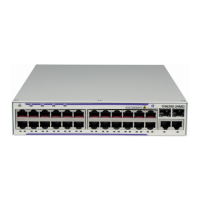Label Distribution Protocol
7210 SAS M, T, X, R6, Mxp MPLS Configuration Guide Page 229
Source and destination IP addresses of LDP messages are the transport addresses, i.e., LDP LSR-
IDs of systems A and B in this case.
Whether the prefix list contains one or more specific /32 addresses or a range of addresses, an
external trigger is required to indicate to LDP to instantiate a targeted Hello adjacency to a node
which address matches an entry in the prefix list. The objective of the feature is to provide an
automatic creation of a T-LDP session to the same destination as an auto-created RSVP LSP to
achieve automatic tunneling of LDP-over-RSVP. The external trigger is when the router with the
matching address appears in the Traffic Engineering database. In the latter case, an external
module monitoring the TE database for the peer prefixes provides the trigger to LDP. As a result
of this, the user must enable the traffic-engineering option in ISIS or OSPF.
Each mapping of a targeted session peer parameter template to a policy prefix which exists in the
TE database will result in LDP establishing a targeted Hello adjacency to this peer address using
the targeted session parameters configured in the template. This Hello adjacency will then either
get associated with an LDP session to the peer if one exists or it will trigger the establishment of a
new targeted LDP session to the peer.
The 7210 SAS OS supports multiple ways of establishing a targeted Hello adjacency to a peer
LSR:
• User configuration of the peer with the targeted session parameters inherited from the
config>router>ldp>targeted-session in the top level context or explicitly configured for
this peer in the config>router>ldp>targeted-session>peer context and which overrides
the top level parameters shared by all targeted peers. Let us refer to the top level
configuration context as the global context. Note that some parameters only exist in the
global context and as such their value will always be inherited by all targeted peers
regardless of which event triggered it.
• User configuration of an SDP of any type to a peer with the signaling tldp option enabled
(default configuration). In this case the targeted session parameter values are taken from
the global context.
• User configuration of a (FEC 129) PW template binding in a BGP-VPLS service. In this
case the targeted session parameter values are taken from the global context.
• User configuration of a (FEC 129 type II) PW template binding in a VLL service
(dynamic multi-segment PW). In this case the target session parameter values are taken
from the global context
• User configuration of a mapping of a targeted session peer parameter template to a prefix
policy when the peer address exists in the TE database. In this case, the targeted session
parameter values are taken from the template.
• Note that features using an LDP LSP, which itself is tunneled over an RSVP LSP (LDP-
over-RSVP), as a shortcut do not trigger automatically the creation of the targeted Hello
adjacency and LDP session to the destination of the RSVP LSP. The user must configure

